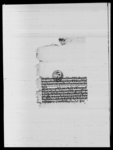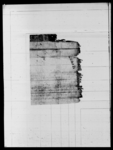A lālamohara of King Girvāṇayuddha emancipating a family of Patan from slavery (1858 VS)
ID: DNA_0012_0065
Edited and
translated by Manik Bajracharya
in collaboration with
Christof Zotter, Simon Cubelic, Rajan Khatiwoda
Created: 2015-07-06;
Last modified: 2018-06-20
For the metadata of the document, click here
The accompanying edition, translation/synopsis and/or commentary are available under the terms of the Creative Commons Attribution-ShareAlike 4.0 International License
Abstract
This lālamohara, dated VS 1802 and issued by King Girvāṇayuddha Vikrama Śāha, emancipates the family of a certain Machindra of Pāṭana Dhalāche Ṭola from slavery.Diplomatic edition
[1r]
1[...]हाये\[royal seal]1स्वस्तिश्रीगिरिराजचक्रचूडामणिनरनारायेणेत्यादिविविधविरूदावलि2विराजमानमानोन्नत्श्रीमन्महाराजाधिराजश्रीश्रीश्रीमहाराजेगिर्वा
3णजुद्धविक्रमसाहवहादुरसमसेरजंङ्देवानाम्सदासमरविज
4यिनाम्¯¯ ¯¯ ¯¯ ¯¯ ¯¯ ¯¯ ¯¯ ¯¯ ¯¯ ¯¯ ¯¯ ¯¯ ¯¯ ¯¯ ¯¯
5आगेसहरपाटन•धलाछेटोलकामछिन्द्रकेअघिनेपालमार्दा
6तिमिहरूलाईह्मासिगुलामीतुल्याय़ाकोहो•आजहामीले•तला
7ई•र•तेराछोराछोरीसमेतकन•गुलामीकापदवीकोनाउ•छोडाई•पा
8रगरिवक्स्यौँ•आफ्नाषातिरजामासँग•कुलाचारदेषी•भैआय़ा
9कोधर्मकर्मजातभाईसितमिलीजुलिछोराछोरीकोविवाहवरी
10गरईतिसम्वत१८५८सालमितिचैत्रसुदि१२रोज४शुभम्
[1v]
1२९७३०1रूजुवम्साह1मार्फत्तवषंतवारसिंह1रूजुसेरवहादु[...]1रूजुनरसिंहTranslation
[1r]
May the venerable Durgā succour [us]!
[Royal seal]
Hail! [A decree] of him who is shining with manifold rows of eulogy [such as] "The venerable crest-jewel of the multitude of mountain kings" and Nāranārāyaṇa1 etc., high in honour, the venerable supreme king of great kings, the thrice venerable great king, Girvāṇayuddha Vikrama Sāha, the brave swordsman, the divine king always triumphant in war.
To Machindra of Dhalāche Ṭola in the city of Patan.
Earlier, when Nepāla (i.e., the Kathmandu Valley) was conquered,2 your family was degraded in cast and made slaves. Today, I have freed you and your sons and daughters by removing the title of your status as slaves. Mindful of proper conduct (khātirajāmā), perform together with your fellow caste brothers the acts of dharma that have been passed down within the tradition of your clan and arrange marriages for your sons and daughters.
Wednesday, the 12th of the dark fortnight of Caitra in the [Vikrama] era year 1858 (1802 CE). [May there be] auspiciousness.
[1v]
297
Attested by Bam Sāha.
Witnessed by Bakhatavāra Siṃha.
Attested by Sera Bahādura.
Attested by Narasiṃha.
Commentary
This document was issued in the year 1802 by King Girvāṇayuddha Vikrama Sāha (r. 1799-1816). The king was only five years old at the time, and was ruling under the regency of Queen Suvarṇaprabhā. The document states that (the ancestors of) Machindra of Dhalāche3 were enslaved (probably by Pṛthvīnārāyaṇa Śāha) during the conquest of the Valley, and that he, together with his offspring, were now being freed. It further states that the subject should, with all good intent, follow the traditions of his clan, establish good relations with his fellow clan members, and arrange marriages for his offspring. The document was attested by Bam Sāha4 , Sera Bahādura5 and Narasiṃha. The document is also signed by Bakhaṃtavāra Siṃha6 as a witness.
Documentary evidence of slavery in Nepal can be traced back to the 7th-century Licchavi king Narendradeva, an inscription of whom in Bhaktapur mentions assigning slaves to a Vaiṣṇava temple.7 So far only a few documents concerning slaves and slavery have been found from the Licchavi and Early Malla periods. In contrast, there are plenty of such documents from the Late Malla and Śāha periods.
D.R. Pant 1997: 137-39 considers a number of documents issued by Pṛthvīnārāyaṇa Śāha relating to the subject of slavery. One of them, issued in 1768, mentions that Pṛthvīnārāyaṇa freed a certain Dhanadatta Nevāra of Lubhu who had earlier been seized by him. For the edition and analysis of this particular document, see Dh. Vajrācārya et al. VS 2014: 27 and N. Pant et al. VS 2025: 1038-1040. Many such manumission documents can be found from the period of later Śāha rulers and throughout the Rāṇā period. Perhaps the most notable such ruler is Deva Śamśera, who, during his very short (114-day) rule, attempted some measures to weaken slavery. A lagata of slaves freed during his inauguration as the prime minister on 22 Phālguna of VS 1957 has been published in Ḍaṅgola et al. VS 2041: 115-120. Another such mass manumission was carried out by Candra Śamśera on 14 Mārga VS 1981.
The subject in the current document, Machindra, was presumably a Newar of Patan. It is not clear from the document which caste of Newars this Machindra belonged to, or whether he or his ancestors belonged to an enslavable caste. Currently, the Dhalāche area in Patan is inhabited mostly by people of the Jyāpu caste. Further study is needed of the rules and practices relating to the manumission of persons enslaved during a war.


